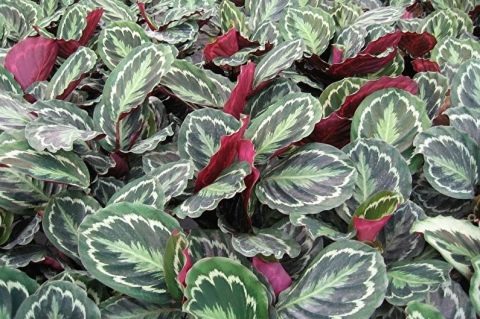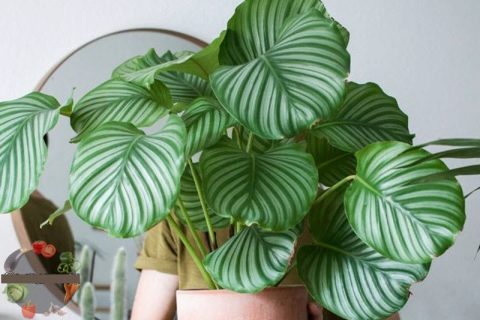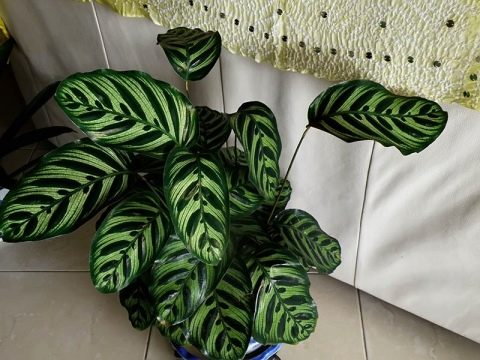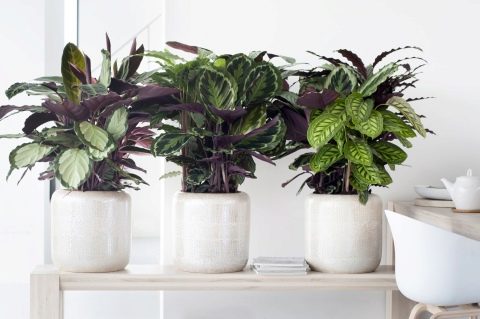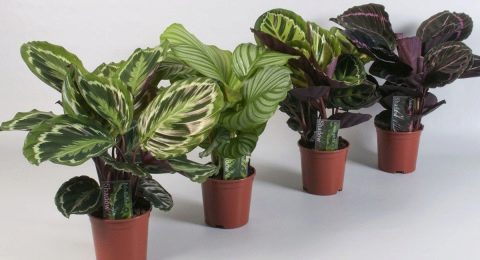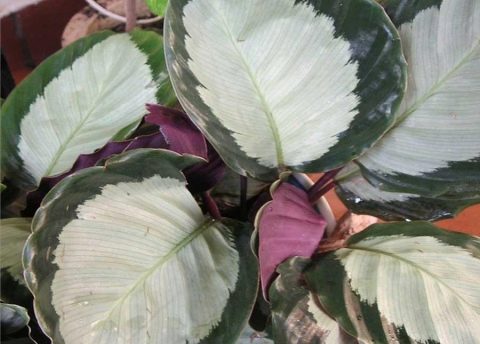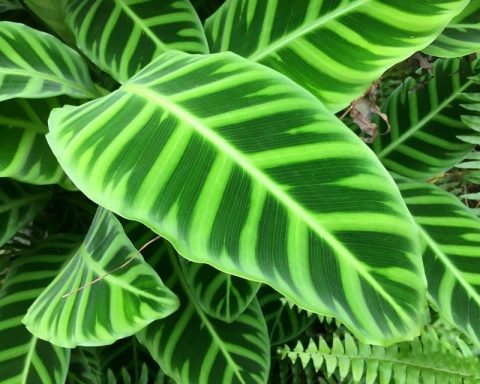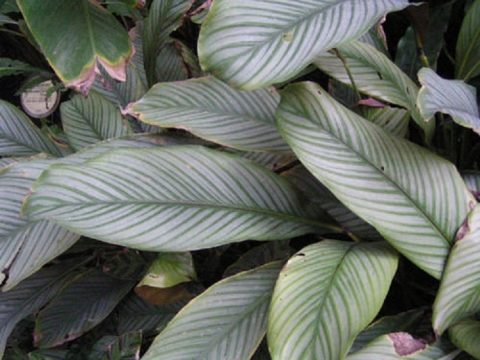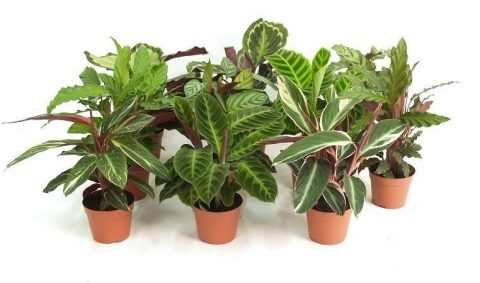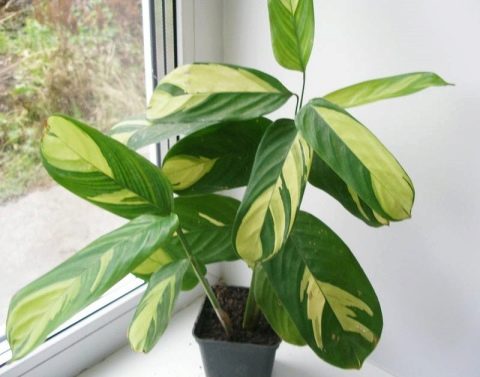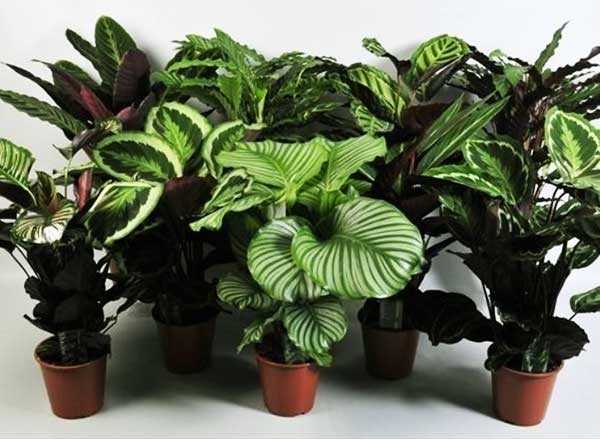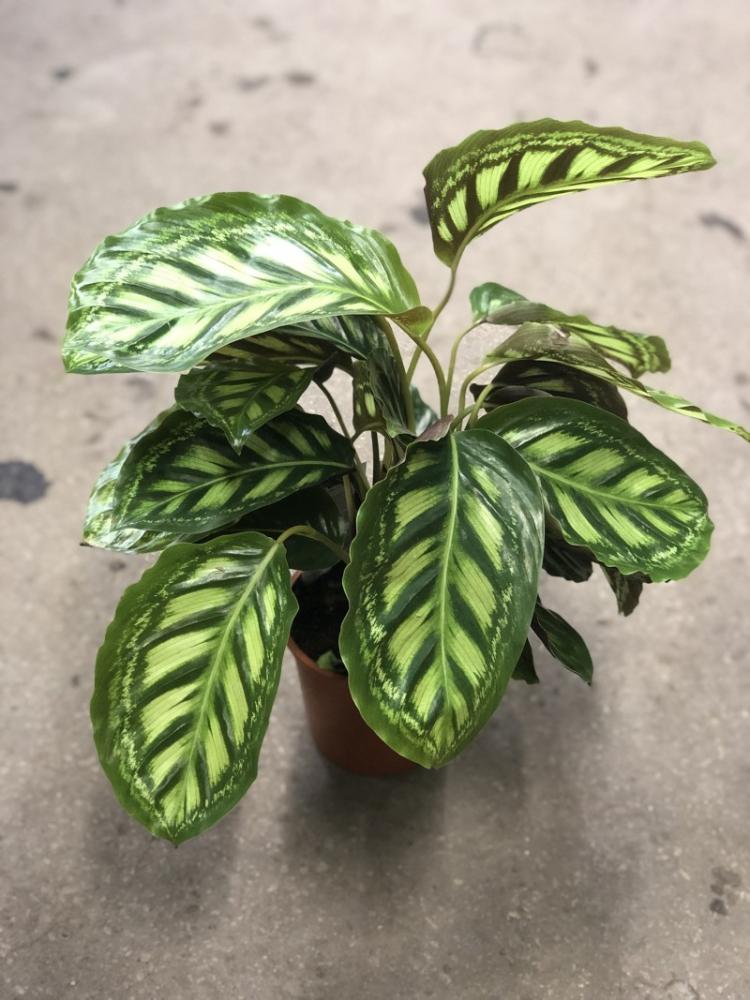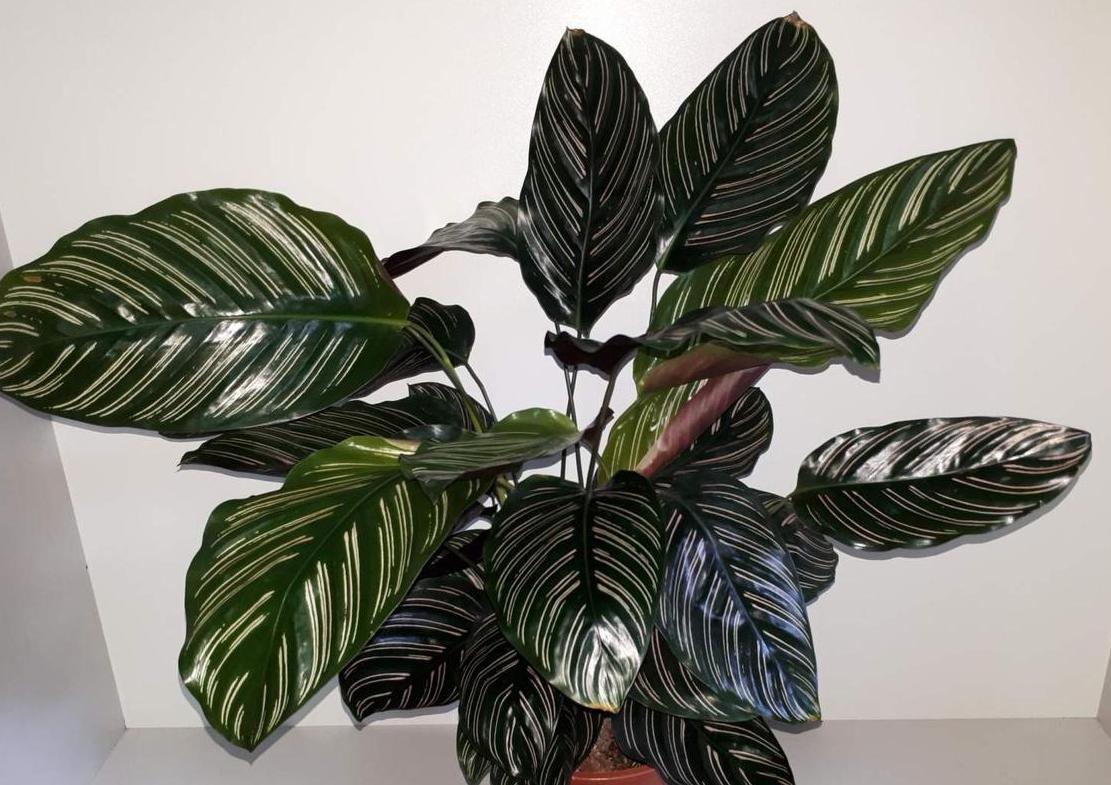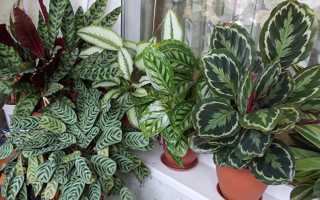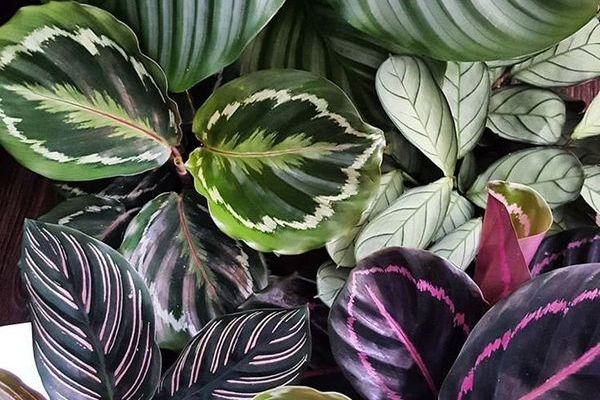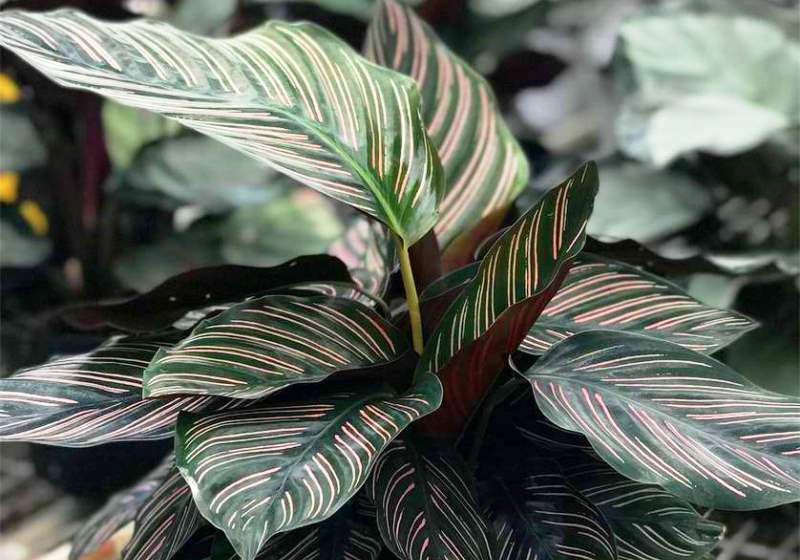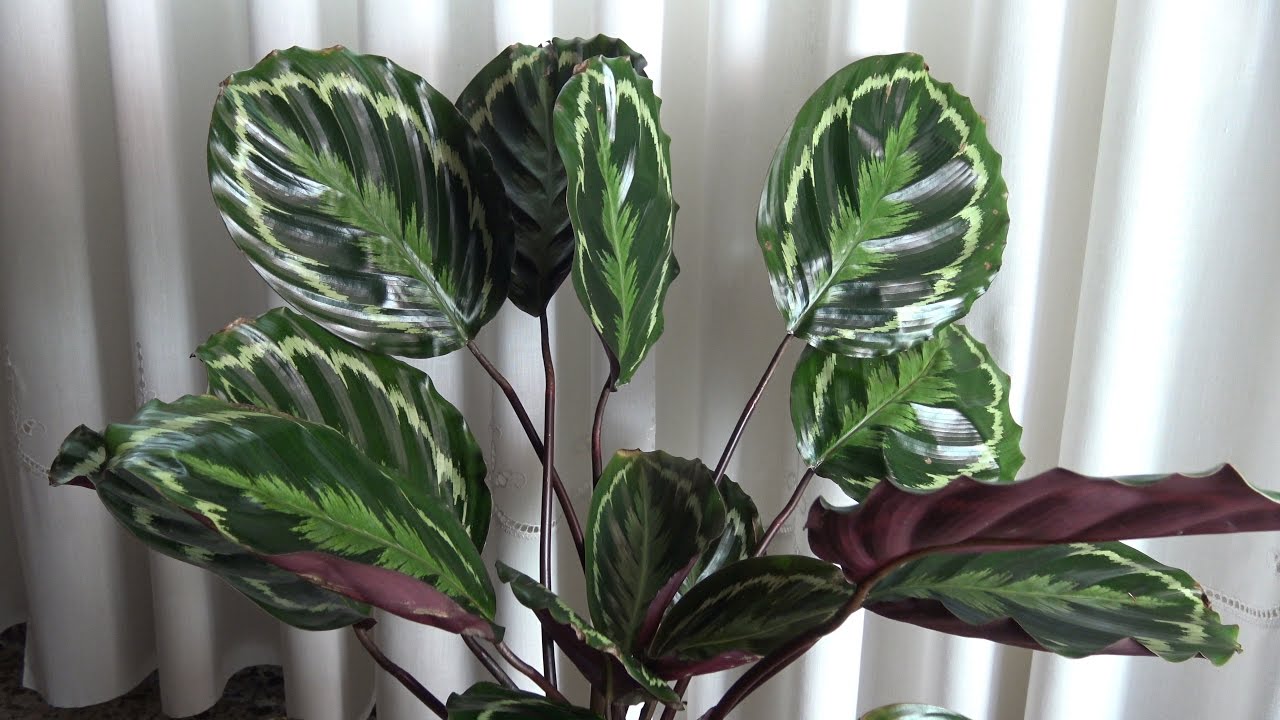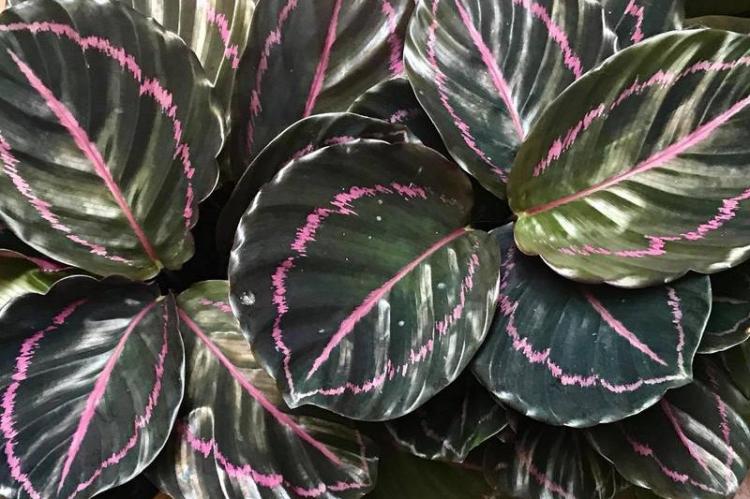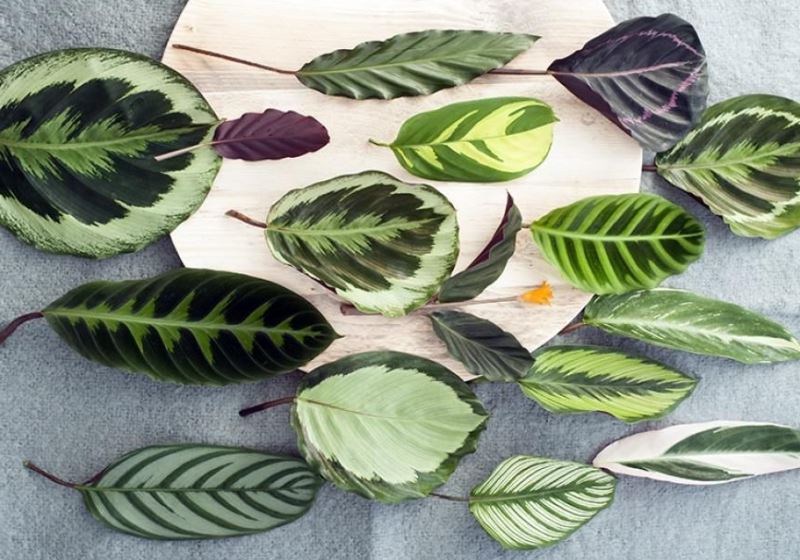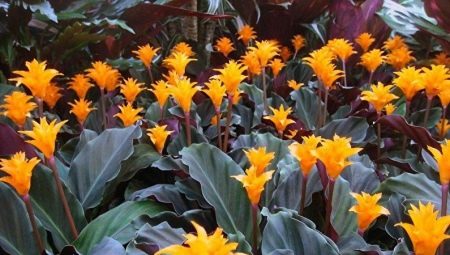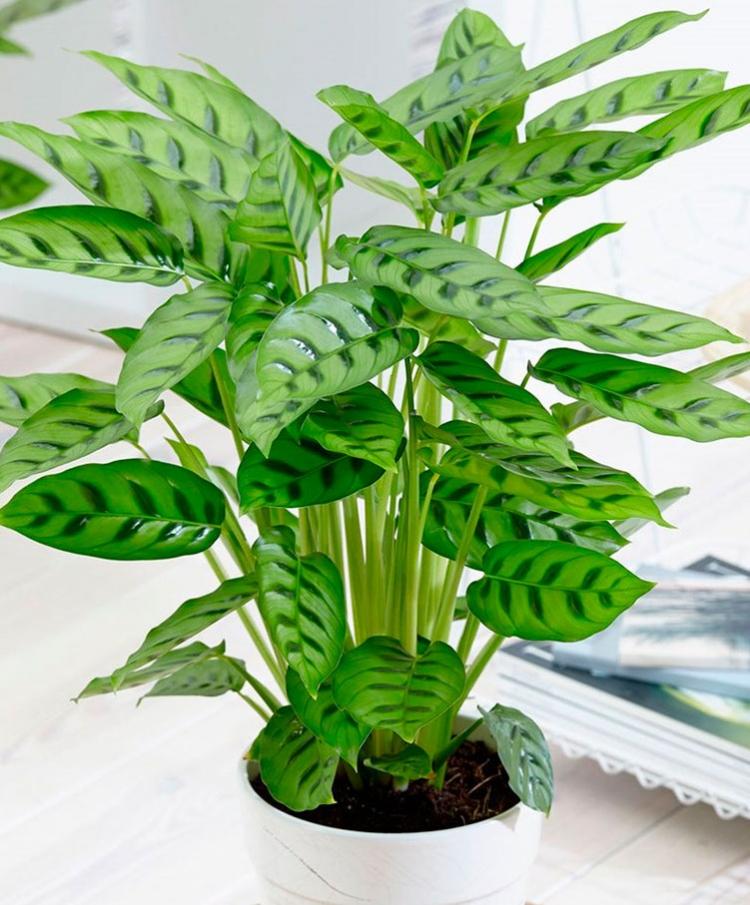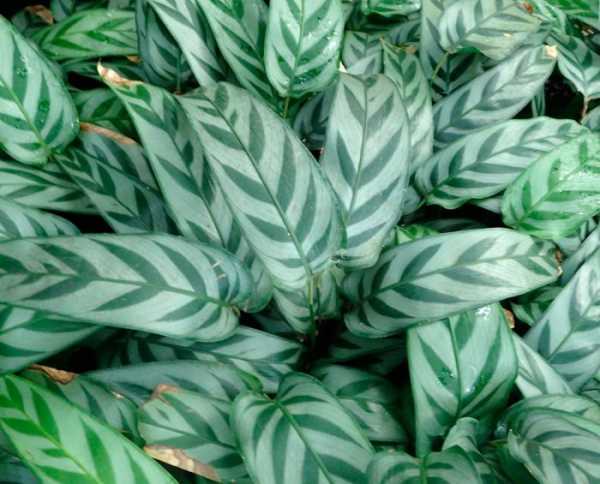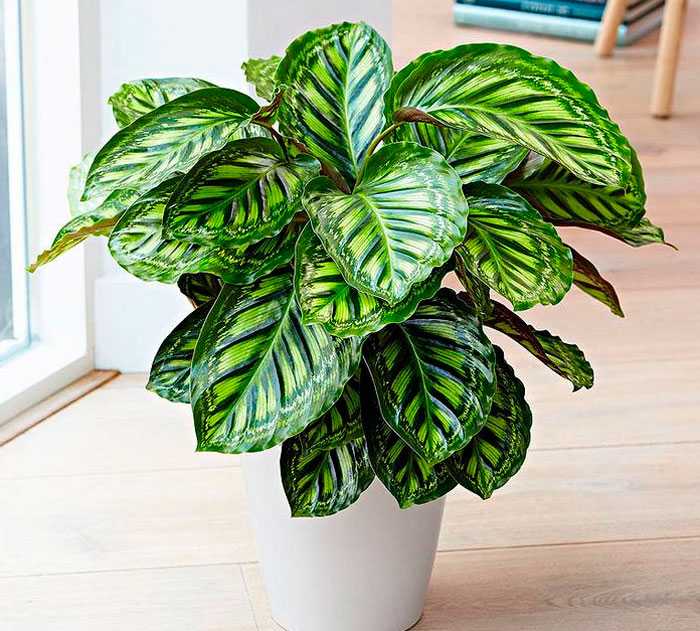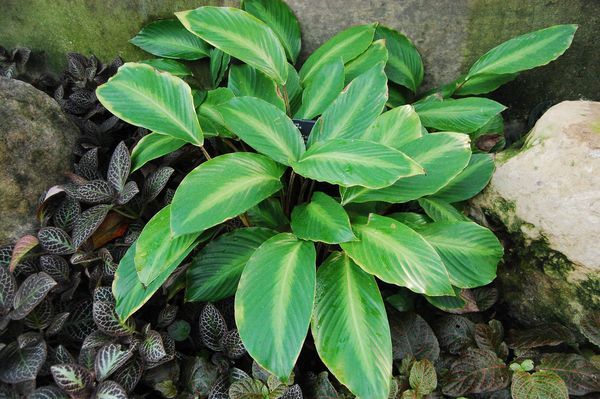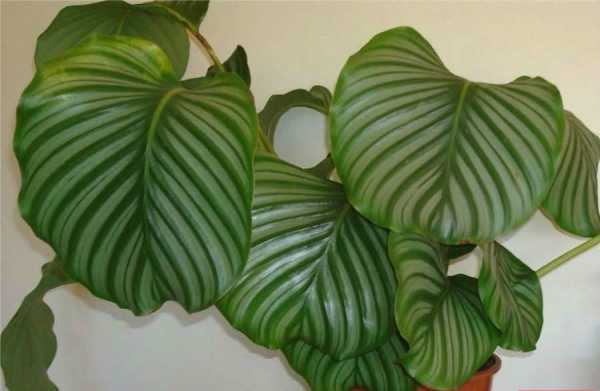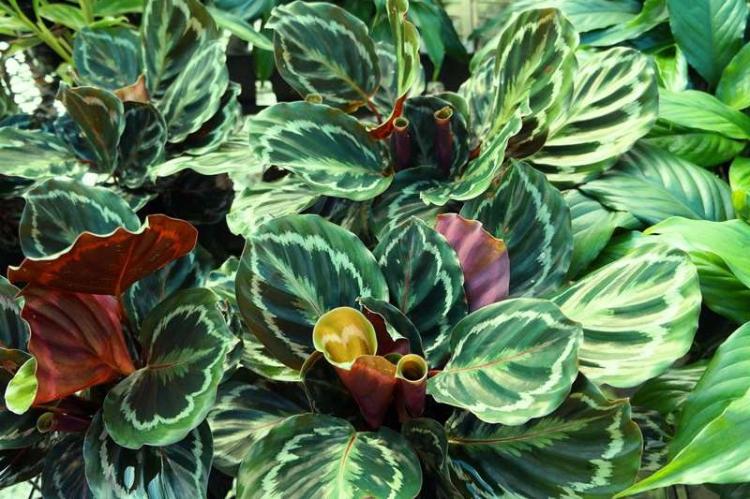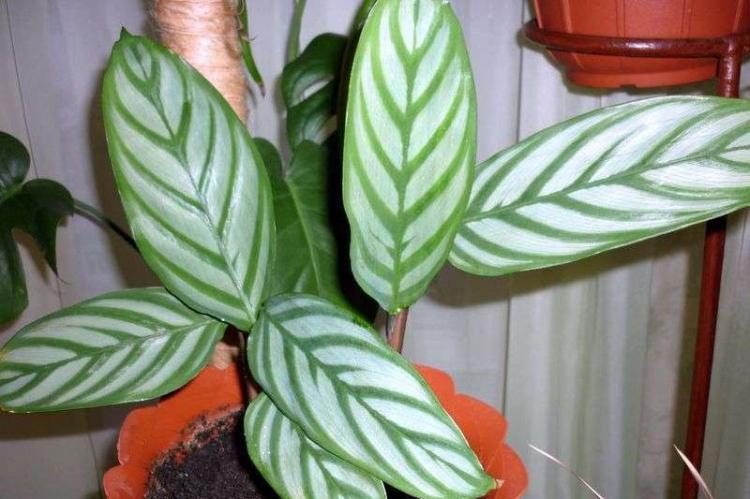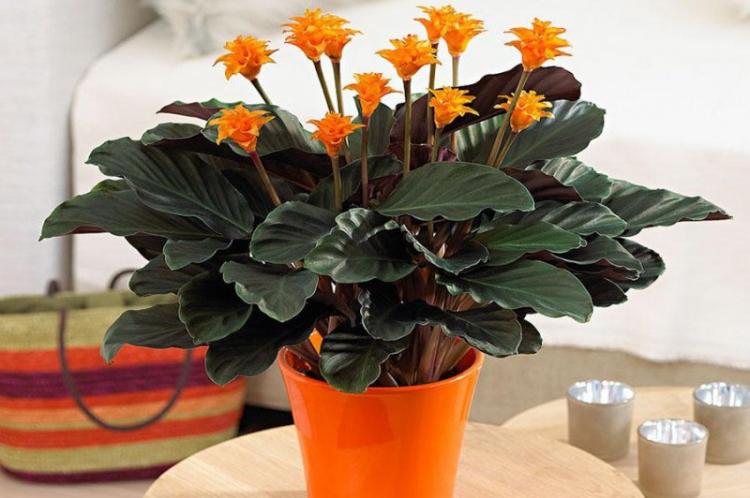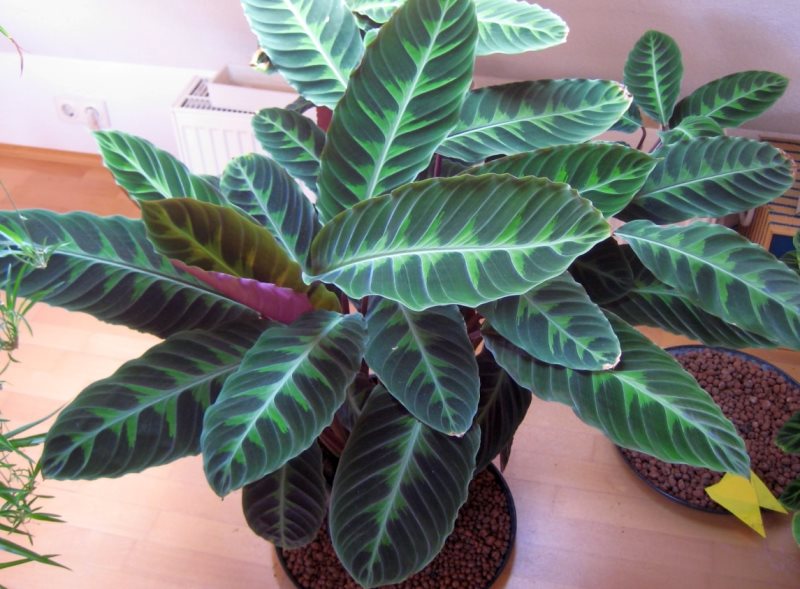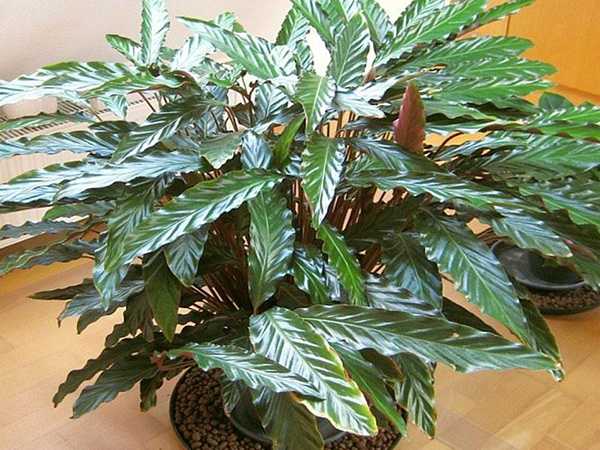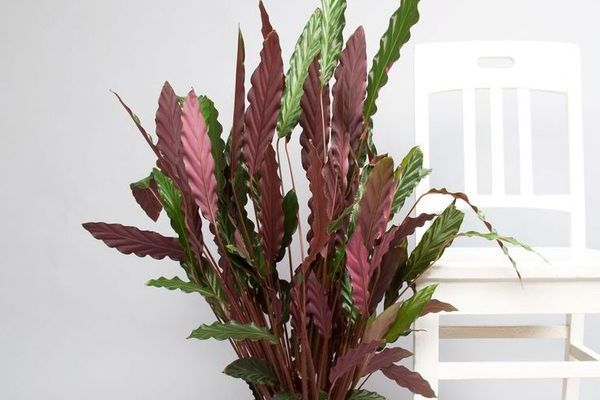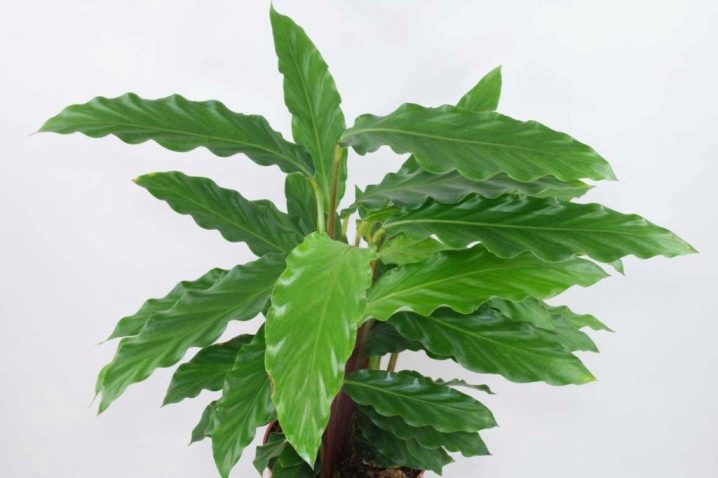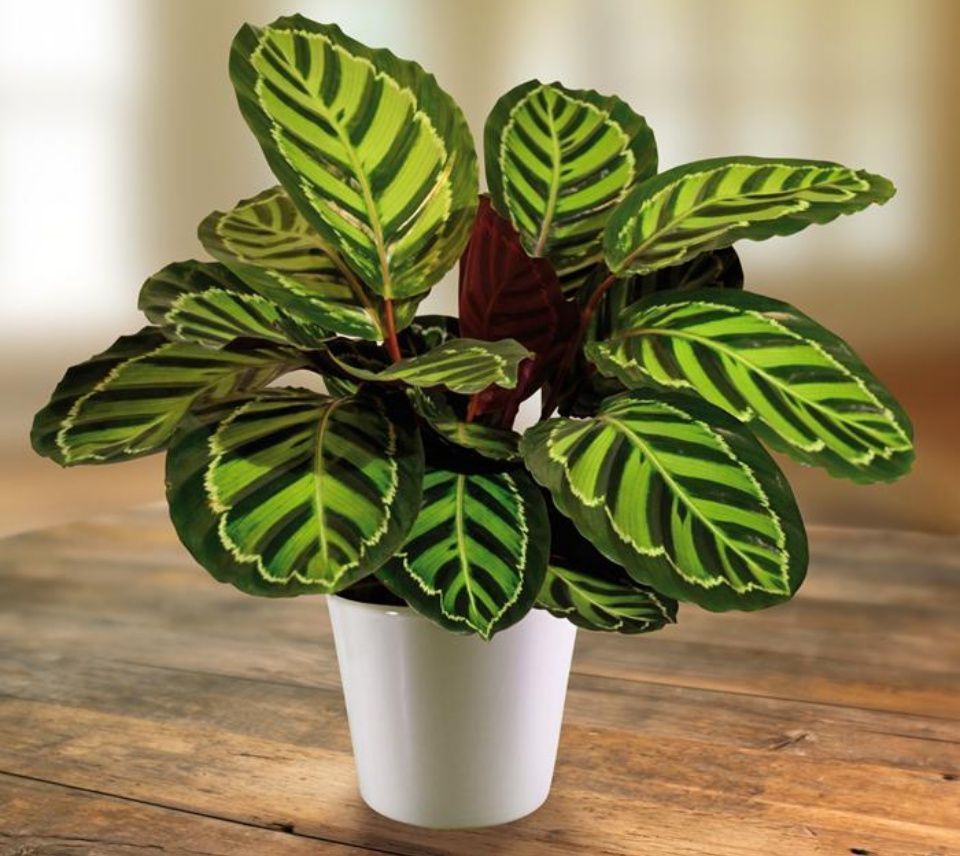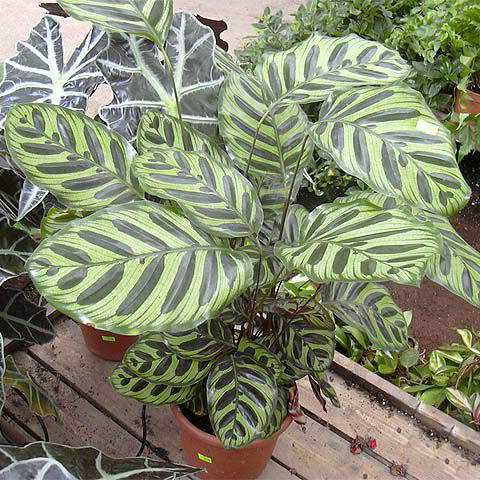Calathea pests and diseases
Insect pests calathea
If you have not created the necessary level of humidity for the calathea, it can become a victim of spider mites, thrips or scale insects. And in that, and in the other, and in the third case, the leaves of the calathea turn yellow and fall off. How to save calathea from pest attacks? If you see a thin cobweb, sticky bloom or light dots on the leaves, take action: scale insects and thrips are destroyed by treating the leaves with soapy water. But if this measure does not help, you will have to apply an insecticide treatment, as is the case with a spider mite.
Calathea leaves dry
If only the tips of the leaves dry out in calathea, the reason is insufficient air humidity. It is necessary to increase the frequency of spraying the leaves and rearrange the plant on wet pebbles. If dry spots appear on the leaves, then these may be traces of sunburn caused by spraying the leaves with too coarse sprays, which, remaining on the leaves, turn into magnifying glasses under the sun's rays. Why is Calathea still drying? Due to insufficient watering, drafts and thrips damage.
Calathea turns yellow
If only the lower leaves of the calathea turn yellow, then this is the natural course of things: old leaves die off, new ones appear. But sometimes the calathea turns yellow not only in the lower part, and there can be at least two reasons for this: firstly, improper watering, and secondly, an overdose of fertilizers. Insufficient watering, as well as excessive or too frequent, can provoke yellow leaves. The earthen lump between waterings should dry out two centimeters deep, otherwise, due to the poor supply of oxygen to the roots, young roots will begin to rot, and the leaves will turn yellow.
As for dressings, even during the period of active growth, half the dose recommended by fertilizer manufacturers is enough for calatheas. Calathea leaves can turn yellow when it gets cold.
Calathea leaves curl
Calathea leaves dry and curl from too dry or cool indoor air or from drafts. As you can see, any malaise of the calathea is caused by a violation of the maintenance rules, and in order not to ask later why the leaves of the calathea curl or why they turn yellow and dry, it is enough to simply observe the agrotechnical conditions for this plant. Calathea is capricious, but nothing is impossible in her demands.
Signs, advice from readers and specialists
Signs regarding calathea are generally positive. One of them says that this flower is a symbol of family happiness, promotes well-being and absorbs negative energy. Due to the presence of this flower in the house, the owners' mood improves and a feeling of joy appears. Calathea prevents family quarrels and helps to end hostility between relatives.
Another sign claims that people who start caring for this flower gain self-confidence, show persistence in achieving their goals, confidently defend their views and easily control negative emotions. Anyone who is ready to carefully and patiently care for a flower can check whether these signs and superstitions make sense.
Due to the whimsicality of this plant and the need for careful care of it, not all growers agree on the simplicity of keeping calathea:
Calathea Rufibarba is undoubtedly one of the most aesthetic representatives of the Marantov family. Caring for it will be easy and fun for experienced gardeners. Beginners in growing plants should choose a less demanding specimen, or, having studied the requirements, prepare in advance the place and conditions for this unusual plant.
Pests
The main pests of this representative of the flora are: spider mites, mealybugs, scale insects, thrips.
For prevention, the leaves of the flower are kept clean. They are periodically sprayed and wiped with a damp cloth.
Once a week, the plant is watered with a stream of warm shower. You must first cover the ground with cellophane.
At the first symptoms of damage, the plant is sprayed with fungicides. "Actellik" or other products similar in composition are perfect.
Also, professional florists recommend using folk remedies - a solution of garlic, ginger, potassium permanganate, alcohol, tar or laundry soap.
general information
Calathea is rightfully considered one of the most capricious domestic flowers. This beauty is very sensitive to many factors, including even the cleanliness of the indoor air. The flower has been observed to react negatively to tobacco odors and harsh chemical odors. The main sign that the plant is sick or does not like something is the loss of the decorative properties of the leaves. They can not only fade, but also dry around the edges, turn yellow and stop rising and falling.
Lighting. Long daylight hours (at least 16 hours) are very important for calathea. But at the same time, it does not tolerate prolonged exposure to direct sunlight. You need to choose shaded window sills or places away from the window. With excessive illumination, the leaves curl up into tubes, turn pale and stop rising and unfolding.
How to care for calathea at home - watch the video.
Calathea belongs to the Amaranth family. The place of its growth is the tropical forests of South America, although the area is much wider - all the tropics except Australia. Amaranths grow on the African continent, in India, in Oceania.
Plants of this family are liana-like or herbaceous. They have a very developed root system, which actively stores moisture and other nutrients. For Calathea, this feature is doubly valuable, since it quickly dies in drought conditions.
Calathea is considered a perennial plant. Representatives of some varieties grow up to 1 m, sometimes more. The trunk is usually decorated with large leaves of various shades of green. Sometimes they are even silvery, and the back side is usually purple, purple, violet.
When folded, the plates resemble hands, which is why the plant is sometimes called a "prayer flower".
Calathea begins to bloom in spring: it releases inflorescences that resemble spikelets.
Lighting
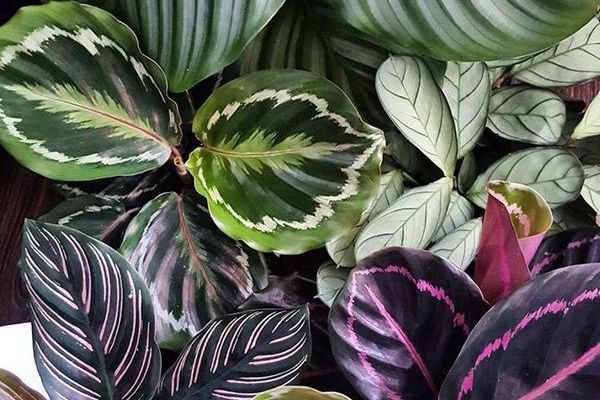
Daylight hours should be approximately 16 hours. You can also put a flower on the north side of the apartment, but you will have to use additional light sources.
Whether the plant has enough lighting or not is noticeable by its leaves. If they are pale, there is little light. If they are small and curl into a tube, too much. If you ignore these symptoms, they will dry out and fall off.
Top dressing
It is important not to overdo it with fertilizers, otherwise serious problems will arise. Top dressing is best applied from April to the end of summer. Once every 14 days, it is necessary to enrich the soil with useful substances that are suitable for deciduous plants
Air humidity
The humidity should be high - about 90%. It is problematic to create such conditions at home. Therefore, sometimes the leaves need to be wiped with a damp cloth or sprinkled with warm water. This moisturizing method is suitable for foliage with a smooth surface.
Calathea care
Lighting. Calatheas are relatively shade-tolerant plants, thrive in diffused light, love bright diffused light. In winter, good lighting is also desirable for plants. Poorly tolerated direct sunlight during the spring and summer months. The size and color of the leaves depends on whether the plant is successfully protected from the sun. If the light is very bright, the leaves lose their color, and the leaf blade also shrinks.
They grow well near the windows of the east and west direction, near the windows of the south direction, shading from the direct sun is mandatory. Calatheas can grow under artificial lighting with fluorescent lamps for 16 hours a day.
Temperature. In the spring-summer period, during the day, the temperature suitable for kalatei is in the region of 22-30 ° С, at night it is slightly cooler. In winter - even at night - not lower than 18 ° С and not higher than 25 ° С. Plants are very sensitive to temperature changes and drafts.
It is very important to maintain a soil temperature of 18-20 ° C, about 22 ° C in summer. Hypothermia of the roots is detrimental to the plant
Watering. Watering is required abundant, as the top layer of the substrate dries. In autumn and winter, watering is somewhat reduced. Watered with warm soft well-settled water
It is important to take care not to overdry, not swamp the soil and prevent the cooling of the root system. Especially sensitive to waterlogging of the substrate Kalathea Makoya
Air humidity. Calathea prefers high humidity (70 to 90%). It requires regular spraying throughout the year. Spray with well-settled or filtered water, with a fine spray, since large drops of water should not fall on the leaves - dark spots may appear on them.
For calathea, it is necessary to choose a place with the maximum air humidity. With dry indoor air, spraying is necessary at least once, and ideally twice a day. To increase humidity, the plant can be placed on a pallet with damp moss, expanded clay or pebbles, or you can use a humidifier indoors. In this case, the bottom of the pot should not touch the water. To maintain high humidity overnight, plastic bags can be put on the plants. Calatheas grow well in mini greenhouses, florariums, terrariums.
Fertilizer. Calatheas are fed from spring to autumn once every 2 weeks with flower fertilizer. In winter, feeding is reduced to 1 time in 5-6 weeks. Calathea reacts poorly to excess calcium and nitrogen in the soil.
Transfer. Young calatheas are transplanted annually, adults - every two years in late spring or summer. When transplanting, old dying leaves are removed. Take a shallow pot for kalata. The soil is humus, loose and permeable, slightly acidic (pH up to 6). A mixture of leafy soil, peat and sand (2: 1: 1) is suitable, to which you can add crushed charcoal. If it is not possible to make up a soil mixture for calathea yourself, then you can use purchased soil for arrowroot, the soil for azalea is also suitable. Good drainage is essential.
Reproduction. Propagated by seeds and dividing rhizomes. Stemless calatheas form rhizomes and nodules. Having reached a respectable age, the rhizomes of plants branch out, and they are easy to divide during transplantation. Large plants are carefully divided into 2-3 new specimens, trying not to damage the roots, and planted in a peat-based substrate, after which it must be thoroughly watered with lukewarm water and allowed to dry before the next watering. The pots are placed in a loosely tied plastic bag and kept in a warm place until the plant hardens and new leaves appear.
Reproduction of calathea
Calatheas are plants of warm greenhouses. There are several ways to reproduce it: by seeds, dividing a bush, cuttings and leaf propagation. I will say right away that the probability of leaf rooting is extremely small, so we will not consider and recommend this method.
Dividing the bush
This is the most common way to propagate calathea. It is best to carry out this operation in the spring. To do this, the plant is removed from the pot, the rhizome is carefully divided so that in each fragment there are a growth point and 2-3 leaves. The delenka is planted in small pots with a diameter of 7-9 cm. The composition of the soil: leafy soil - 1 hour, peat soil - 1 hour, sand - 1 hour. Keep at a temperature of at least 20 °.
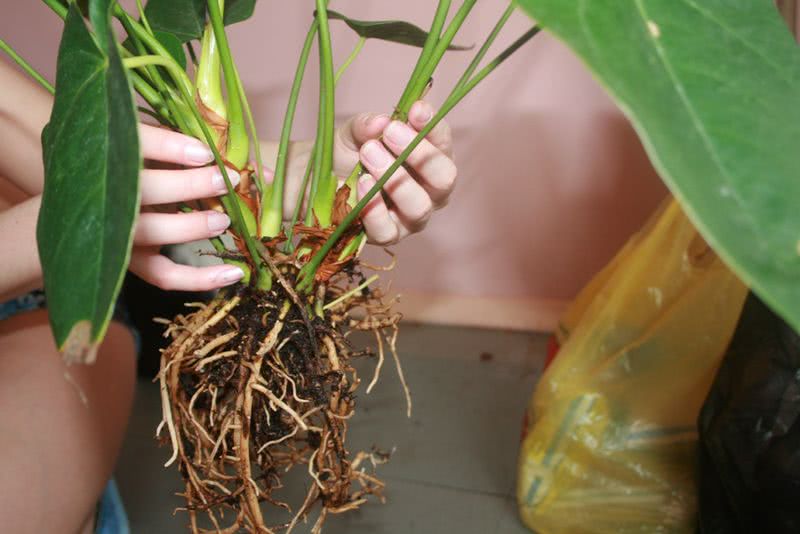
After rooting and development of the root system, young plants are transferred to 9-11 cm pots with a good drainage layer. The earthen mixture is made up of leafy soil - 1 hour, soddy - 1 hour, peat - 1 hour, humus - 1 hour, sand - 1 hour. The main care of plants consists in maintaining the temperature at least 20 ° (preferably 22-24 °), abundant watering and spraying, shading from the bright rays of the sun.
Propagation by cuttings
To do this, a small aerial petiole is cut off from the plant and planted in a moist earthen substrate. Cover with a plastic bottle or a transparent bag. And they keep it that way until the plant takes root.
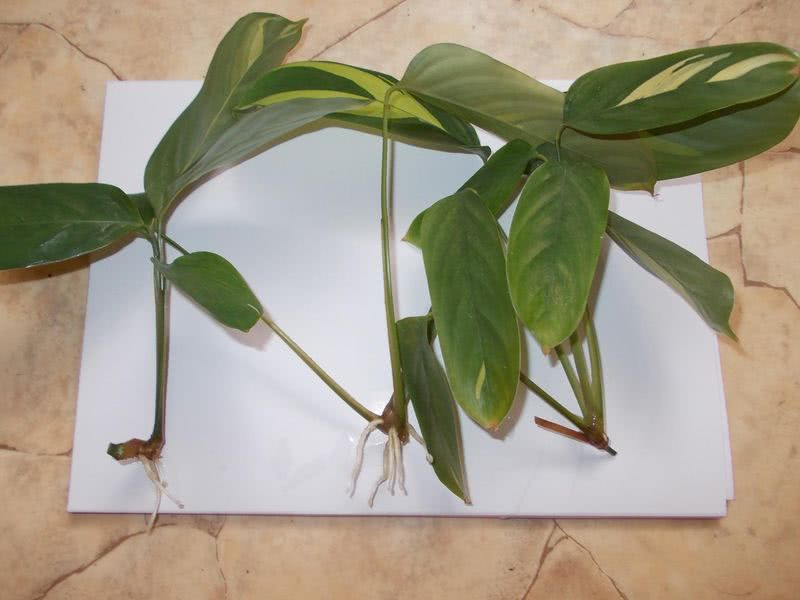
Unfortunately, not all types of calathea can be propagated in this way.
Growing from seeds
Growing a tropical beauty from seeds is the most labor-intensive way, since even high-quality seeds do not germinate. When propagated by seeds, they are sown in bowls. In this case, an earthen mixture is used: leaf soil - 1 hour, sand - 1/2 hour. The temperature should be 22-24 °.
After the first true leaves appear at the seedlings, they are dived into bowls or boxes with the same composition of the earthen mixture. When they get stronger, they are transplanted into 5-7 cm pots.
Description
Calathea grows in tropical forests and belongs to the arrowroot family. It is a perennial plant that has a well-developed root system, while it can have both a normal root and a tuber. Their sizes reach one meter, and sometimes even more. Calathea leaves are oval in shape and grow up to 30 centimeters or more in length. In addition, they can be both glossy and velvety, but one of its sides can be painted in reddish or even brown shades, which form rather complex patterns. Above, the leaves are divided into small segments by thin lines. All leaves are located on small internodes.
Many people call this plant "prayer flower". The name was given to him due to the fact that in the evening, calathea raises its variegated leaves up, as if hands in prayer. But in the morning they are located horizontally. Each year, such a houseplant throws out up to six leaves.
Calathea has flowers that slightly resemble inflorescences in the form of a spikelet. Flowering lasts approximately 3 weeks. In each species, it occurs at different times, from early spring to autumn. Their colors are quite varied from pale white to dark purple. Orange flowers are especially beautiful.
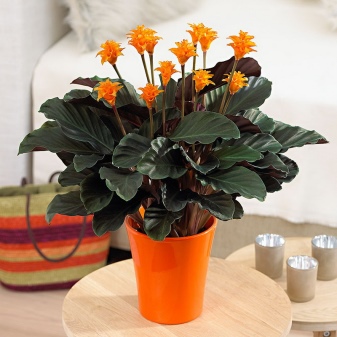
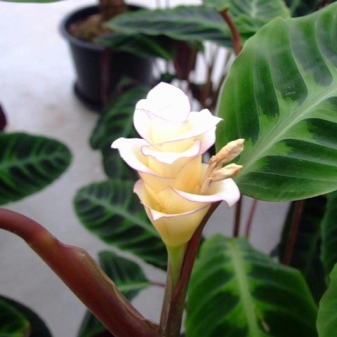
Varieties of calathea
The population of kalata is more than 150 plant species in the arrowroot family. Among domestic florists, the following types are most common:
Calathea Varshevich. The plant is tall, up to 1.2 m, with rather large leaves, velvety, with shiny villi. Has a contrasting pattern with lighter patterned stripes on a dark green leaf plate. The petioles of the leaf plate are dark purple in color. Watering is moderate. Spraying is permissible around the plant with a "fine mist", since brown spots are formed when water gets on the leaves;
Calathea Bahema
Low-growing view - 15 - 20 cm. It attracts attention with a silvery sheen on the light green leaf plate. There are dark green spots along the central vein on both sides
This species belongs to flowering species, which is rare among kalata. Inflorescence - spikelet;
Calathea Vic. Plant height can reach 1 m. Leaf plates are oval, slightly pointed towards the ends. The color is dark green with a yellowish-green pattern on top and light yellow stripes on the bottom. Blooms;
Calathea Zebrina (striped). A medium-sized plant - up to 60 cm. The leaves have short petioles 10 - 15 cm. The length of the leaf plate is about 40 cm, and the width is about 15 cm. The upper part of the leaf is colored dark green with wide contrasting stripes. The bottom of the leaf plate is red;
Calathea Makoya. Plant height can reach 50 cm.The leaves are oval in dark green color. The upper part of the leaf plate is painted with green stripes and red spots;
Calathea saffron. The leaves are dark green above and brown below. In this species, flowering can be stimulated by artificially creating temperature drops and reducing daylight hours to 9 hours, covering the plant with a dense cap or removing it to a dark room. Flowers are bright yellow, spike-shaped;
Calathea Rufibarba. It has two varieties: "Blue Grass" with a green underside of the leaf plate and "Wavestar" - with a dark lilac;
Calathea is wonderful. It has lanceolate leaf plates - narrow, long, with a wavy edging. Leaves are dense, light green with dark green oval spots. The back of the leaf is purple.
Despite the variety of species, calatheas have slight differences in care. Basically, these are watering requirements. Some species categorically do not tolerate excess moisture (for example, Varshevich's calathea).
Description
Calatheas were brought to us from the warm and humid rainforests of South and North America, being one of the many colorful and unique accents of this evergreen forest. Calathea is often confused with arrowroot, but these are two different types of plants, both extremely decorative.
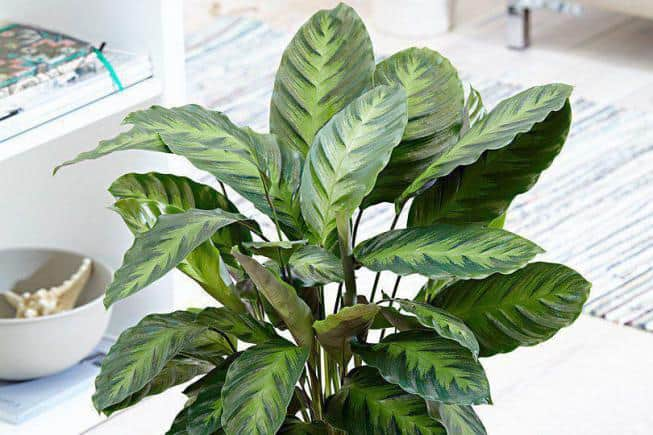
The genus includes numerous species of herbaceous plants, evergreen perennials, which in our climate are considered as ornamental plants, grown at home, while in countries with warm climates, they can be grown as garden plants. The main advantages of these plants are highly decorative leaves, different in terms of shape and color. Leaves, planted on long petioles, with pigment spots and variable patterns, depending on the species (including white stripes, patterns, edges in various shades of green, purple, silver, bronze).
The flowers are inconspicuous, collected in a brush, hardly noticeable. But there are also exceptions, for example, saffron calathea, which, in addition to decorative leaves, fascinates with yellow-orange flowers. Among the many species, there are also species with an edible underground part. The height of a flower grown at home is in the range of 30-100 cm.



